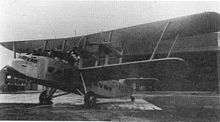Short Scylla
| L.17 Scylla | |
|---|---|
 | |
| Role | Biplane airliner |
| Manufacturer | Short Brothers |
| First flight | 26 March 1934 |
| Retired | 1940 |
| Primary user | Imperial Airways |
| Produced | Rochester |
| Number built | 2 |
| Developed from | Short Kent |
The Short L.17 Scylla was a British four-engined 39-seat biplane airliner designed and built by Short Brothers at the request of Imperial Airways to supplement the Handley Page H.P.42 fleet already in service after Handley Page quoted an excessive price for two additional H.P.42s.
Imperial Airways used the Scylla for scheduled flights from London to Paris and other European cities. Two aircraft were built, Scylla (G-ACJJ) and Syrinx (G-ACJK). Both served with the airline until its merger into BOAC in 1939 and both were taken out of service the following year.
Design and development
The Scylla was a land-based development of the Short Kent (S.17) flying boat, essentially using the Kent's aerostructure above a redesigned fuselage.[1] It was an all-metal biplane (wingspan of 113 ft, 34,44 m) powered originally by four Bristol Jupiter XFBM radial engines mounted on vertical struts between the upper and lower planes. The square-section braced-framed fuselage was below the lower wing; the tail had a single vertical stabilizer and a horizontal stabilizer at about one quarter height. The Scylla was originally fitted with a Flettner-type servo tab trim control[2] to ease the forces on the rudder controls. An experimental servo tab on the rudder was tested on G-ACJJ Scylla for a time. Experience gained with the latter possibly contributed to a later patent application submitted jointly by Shorts and Dudley Lloyd Parkes on 7 August 1936.[3]
The main undercarriage had one fixed wheel on each side, mounted on three diagonally-braced struts, one to the upper and two to the lower edge of the fuselage; there was a single tailwheel. Ailerons were fitted to both upper and lower wings.
The engine nacelles were designed to receive Bristol Jupiter, Pegasus or Perseus engines without modification,[1] a far-sighted provision which later enabled e.g. the two inboard Jupiters of G-ACJK Syrinx readily to be replaced with Perseus IIL sleeve valve engines, to test their performance in airline conditions. When Syrinx was re-built (after it had been severely damaged when blown over by sidewinds while taxiing at Brussels airport), it was fitted with four Pegasus XC engines.

Operators
Specifications
Data from Barnes and James, p.278,
General characteristics
- Crew: four
- Capacity: 39
- Length: 83 ft 10 in ft (25.5 m)
- Wingspan: 113 ft (34.44 m)
- Height: 31 ft 7 in [4] (9.6 m)
- Wing area: 2,615 ft² (243 sq.m)
- Empty weight: 22,650 lb (10,290 kg)
- Loaded weight: 33,500 lb (15,200 kg)
- Powerplant: 4 × Bristol Jupiter XFBM air-cooled radial, 555 hp (414 kW) each
Performance
- Maximum speed: 137 mph (220 km/h)
The two L.17 aircraft, G-ACJJ Scylla and G-ACJK Syrinx, had at different times three different engine configurations between them:
- Four Bristol Jupiter XFBM one-row radial poppet valve piston engines of 595 hp (444 kW) each
- Two Bristol Jupiter XFBM radial poppet valve radial piston engines of 595 hp (444 kW) (outer pair) and two Bristol Perseus IIL sleeve valve radial piston engines of 540 hp (400 kW) each (inner pair)
- Four Bristol Pegasus XC radial poppet valve piston engines of 660 hp (492 kW) each
See also
- Related development
Notes
References
- Barnes C.H. & James D.N (1989). Shorts Aircraft since 1900. London: Putnam. p. 278. ISBN 0-85177-819-4.
- Cassidy, Brian (2004). "Flying Empires: Short 'C' class Empire flying boats" (PDF). Queens Parade Press. Retrieved 2007-01-15.
- Gunston, Bill (editor) (1980). The Illustrated Encyclopedia of Propeller Airliners. London: Phoebus. ISBN 0-7112-0062-9.
- "Century-of-Flight.net: Short Scylla". Retrieved 2007-01-18.
- "Short L17 Scylla". Imperial Airways project. Retrieved 2007-01-24.
External links
![]() Media related to Short Scylla at Wikimedia Commons
Media related to Short Scylla at Wikimedia Commons